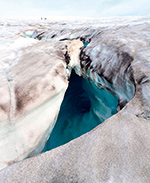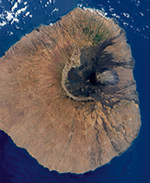- Climate change threats and natural hazards
- > Climate change will have a twofold adverse impact on coastal ecosystems through warming and acidification. However, for humankind the greatest direct threat will come from sea-level rise which is likely to cause more frequent flooding in many regions in the future. As a result of ever denser coastal settlement, natural hazards may in future lead to catastrophes. Modern warning systems may help to limit the damage caused.

Climate change and natural hazards threaten the coasts
The intensity of the impact of climate change on coastal habitats depends to a large extent on the levels of carbon dioxide (CO2) in the Earth’s atmosphere. The direct consequence of heavy CO2 emission is a gradual warming of the atmosphere, which causes a warming of the surface water, and that, in turn, inhibits its mixing with the underlying cooler and denser water.
This then reduces the amount of oxygen-rich water being introduced into the deep layers, which can result in an oxygen deficiency. It is difficult for animals such as crabs, clams or fish to survive in such areas.
Tropical coral species are also affected by the warming. It is presently believed that around 20 per cent have been irretrievably lost through warming and other stress factors such as marine pollution, and at least another 30 per cent severely impaired.
In other marine organisms it is often the eggs and larvae that react sensitively to ocean warming. For the Northeast Atlantic cod it can mean an early death. Yields in the economically important cod fishery could fall drastically in the Barents Sea in the future.
Another consequence of climate change is acidification of the oceans. This is due to the increasing dissolution of CO2, which produces acid. Marine organisms that secrete calcareous shells or form skeletons are most severely affected by this. In corals, clams and snails, the calcite formation declines by 22 to 39 per cent in acidified water, depending on the animal group in question. On the other hand, studies now indicate that some marine organisms can cope with acidification over the course of several generations.
For humankind, climate change represents a hazard as a result of the sea-level rise that it causes. Since 1990, sea levels have been rising annually by around 3 millimetres; this rate will likely accelerate with sustained CO2 emission levels. By the year 2100 it is expected that global sea level will have risen by an average of up to 1 metre.
In addition to the consequences of climate change, there are also a number of natural hazards that impact the coasts. These include earthquakes, landslides and tsunamis, as well as natural climatic phenomena. Although humans have no influence on the occurrence of such events, a number of technical solutions have been developed to protect coastal populations as far as possible. There have been many cases where lessons were learned from disasters such as tsunamis, which are usually triggered by earthquakes. While Japan and the USA have had warning systems operating since the middle of last century, they were first installed in the Indian Ocean region after the tsunami of 2004.
Tsunamis can also be triggered by landslides. These are generated when large volumes of sand or sediment break off on slopes and plunge into deeper water. As a rule, such local events do not have the long-distance consequences of a tsunami wave initiated by an earthquake. Extreme wave heights of over 100 metres are possible, however.
Coastal habitats can also be affected by the El Niño climate phenomenon, which occurs every three to ten years in the tropical Pacific. It can lead to severe aridity in South East Asia and torrential rainfall in South America.
In addition, water temperatures in the Pacific change, causing a collapse of the large fish stocks off South America. The losses by fisheries are extensive.

